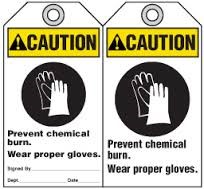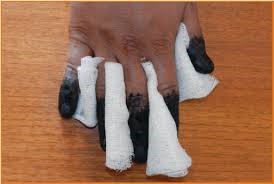Identifying Major Types Of Burns In The Workplace
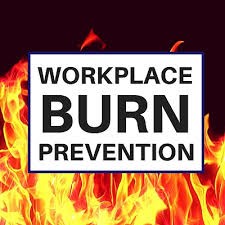 The most common types of burns that occur in the workplace are Thermal, Electrical and Chemical. Equipment, like the one pictured below, can be the source of several of these types of burn injuries, each with it’s own characteristics. The characteristics for these common types of workplace burns are noted below:
The most common types of burns that occur in the workplace are Thermal, Electrical and Chemical. Equipment, like the one pictured below, can be the source of several of these types of burn injuries, each with it’s own characteristics. The characteristics for these common types of workplace burns are noted below:
- Thermal burns. These burns are the result of exposure to or contact with steam, flames, flash and hot surfaces or hot liquids with a temperature above 115 degrees Fahrenheit.
- Electrical burns. An electrical burn occurs when a current traveling through the body meets resistance in the body’s tissues that results in heat burn injuries.
- Chemical burns. Chemical burns are caused by substances that produce a chemical change in skin with or without heat production. Chemical burns continue to do damage until the chemical reaction is complete or until the chemical is flushed away.
Recognizing the Severity of Burns
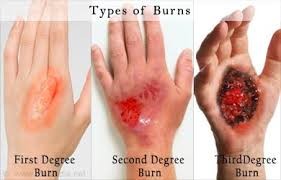 A key factor in burn safety is recognizing the severity of a burn. Burns are categorized in 3 degrees of severity:
A key factor in burn safety is recognizing the severity of a burn. Burns are categorized in 3 degrees of severity:
- First degree burn. These are superficial burns. They are painful, red, dry and blanch with pressure.
- Second degree burn. Second degree burns range from superficial partial-thickness burns with blisters to deep partial thickness burns. They may be red and wet or white and dry depending on the degree of vascular injury.
- Third degree burn. The most severe type of burn, these are full-thickness burns that usually require skin grafts to heal. The skin and tissue below are destroyed.
Treating the Different Types of Burns
 It is vital to minimize the exposure a person has to a burn hazard in order to lessen the potential for severe injuries. Once the severity of a burn is determined, it is important to know how to treat the victim based on the type of burn they were exposed to:
It is vital to minimize the exposure a person has to a burn hazard in order to lessen the potential for severe injuries. Once the severity of a burn is determined, it is important to know how to treat the victim based on the type of burn they were exposed to:
Thermal Burns
- Move the person to a safe area and stop the burning. If clothing is in flames or smoldering, roll the person in a blanket to smother the flames or douse with large quantities of the cleanest water available.
- For a first degree burn, immerse the body in cool water. Give the injured person a pain reliever and water, apply aloe vera gel or burn cream and elevate the burned extremity to reduce swelling.
- For a second degree burn, follow the steps for treating a first degree burn but do not apply cold water.
- For a third degree burn, cover the burn with dry, sterile, nonstick dressing, treat for shock and seek immediate medical attention.
Electrical Burns
- Make the scene safe. Turn off the power.
- Do not approach the injured person until the power is off.
- Check the airway, breathing and circulation. Treat for shock.
- Seek immediate medical attention.
- Remove contaminated clothing.
- Brush off any loose powder and flush the area with water for a minimum of 20 minutes.
- If the chemical has gotten into the eye, flush the eye with clean, clear water from a low pressure source. Keep the eye open when flushing.
- Cover with dry, sterile, nonstick dressing and seek immediate medical attention.
Planning and Prevention
The plan for any work environment is to take steps to ensure burn hazards don’t occur. This can be achieved by using a planning and preventing training approach.
Plan: train workers to be aware of burn safety protocols.
Prevent: instruct workers on how to identify potential burn hazards as well as taking the appropriate steps to prevent them.
Planning for Burn Hazards
- Determine burn dangers associated with the job or work space. Follow appropriate Standard Operating Procedures (SOP).
- Know the location of the nearest first aid, eye wash station and fire equipment before beginning the job functions.
- When performing electrical work, follow Lock-Out/Tag-Out procedures and wear appropriate clothing and Personal Protection Equipment (PPE).
- Read chemical labels and Safety Data Sheets (SDS) sheets to know the required PPE before working with a substance.
Burn Prevention
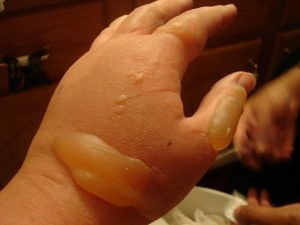 Keep sparks and open flames away from combustible and flammable materials. Don’t allow debris to accumulate in your work area.
Keep sparks and open flames away from combustible and flammable materials. Don’t allow debris to accumulate in your work area.- Store and handle chemicals correctly and according to directions. Read labels and the SDS for any chemical you work with.
- Make sure to wear all appropriate PPE and are familiar with SOP’s and particulars of the equipment.
- Avoid reaching over or through hot surfaces, pipes or chemicals.
- Pipes can break under pressure. Ensure line breaking procedures are followed before you begin work.
- If you are not sure if equipment is hot, do not approach or touch without the proper protective equipment. When it comes to burn hazards, always use extra caution.
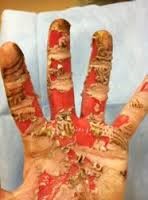 Learning to spot a potential burn hazard, identifying the severity of a burn and what actions to take in each type of burn scenario will not only make employees be more effective at reducing the risk of burn hazards in the workplace but also aid in mitigating the level of injury caused if an incident does take place.
Learning to spot a potential burn hazard, identifying the severity of a burn and what actions to take in each type of burn scenario will not only make employees be more effective at reducing the risk of burn hazards in the workplace but also aid in mitigating the level of injury caused if an incident does take place.
Safety Alert
BACKGROUND: On a winter morning in the Southeast, a logging company employee was attempting to build a warming fire at the logging site.
PERSONAL CHARACTERISTICS: The individual was 48 years old and had been working in the woods for over 20 years. He was a utility man on the landing, responsible for moving trailers, trimming loads, etc.
UNSAFE ACTS: The employee poured a mixture of diesel fuel and some gasoline onto the small fire that he had started for warming to get it going better. (He had asked his employers for permission to start a warming fire. The owners of the operation denied permission, but the employee went ahead and started a fire anyway.)
ACCIDENT: As he poured the fuel mixture onto the existing fire, the fire kicked back and set the employee’s clothes on fire. The employee then started to run, which caused the fire to intensify.
INJURY: Two other employers, both firefighters for their local fire department, chased the employee down and put the fire out (with the assistance of “Coldfire”). The employee was burned on over 70% of his body: 40% were third-degree burns, and 30% were second-degree burns. The employee was taken to a burn center to receive extensive, ongoing, long-term medical treatment.
RECOMMENDATIONS FOR CORRECTION:
- Warming fires should be discouraged at logging sites.
- If fires are allowed, they should be contained (i.e., in some safe type of burn barrel).
- A fire extinguisher should be readily accessible at any warming fire.
- Flammable or combustible liquids-including gasoline, chain saw fuel, or diesel fuel-should not be used to start a fire or to revive one.
- All employees should be trained in first aid, including how to treat burns until medical attention can be provided.
- Remember: “stop, drop, and roll!”
Helpful Links
http://www.saferemployees.co/?p=736
http://loggingsafety.com/safety_alerts?date_filter%5Bvalue%5D%5Byear%5D=&keys=burns
https://www.usfosha.com/osha-articles/workplace-burn-prevention.aspx

